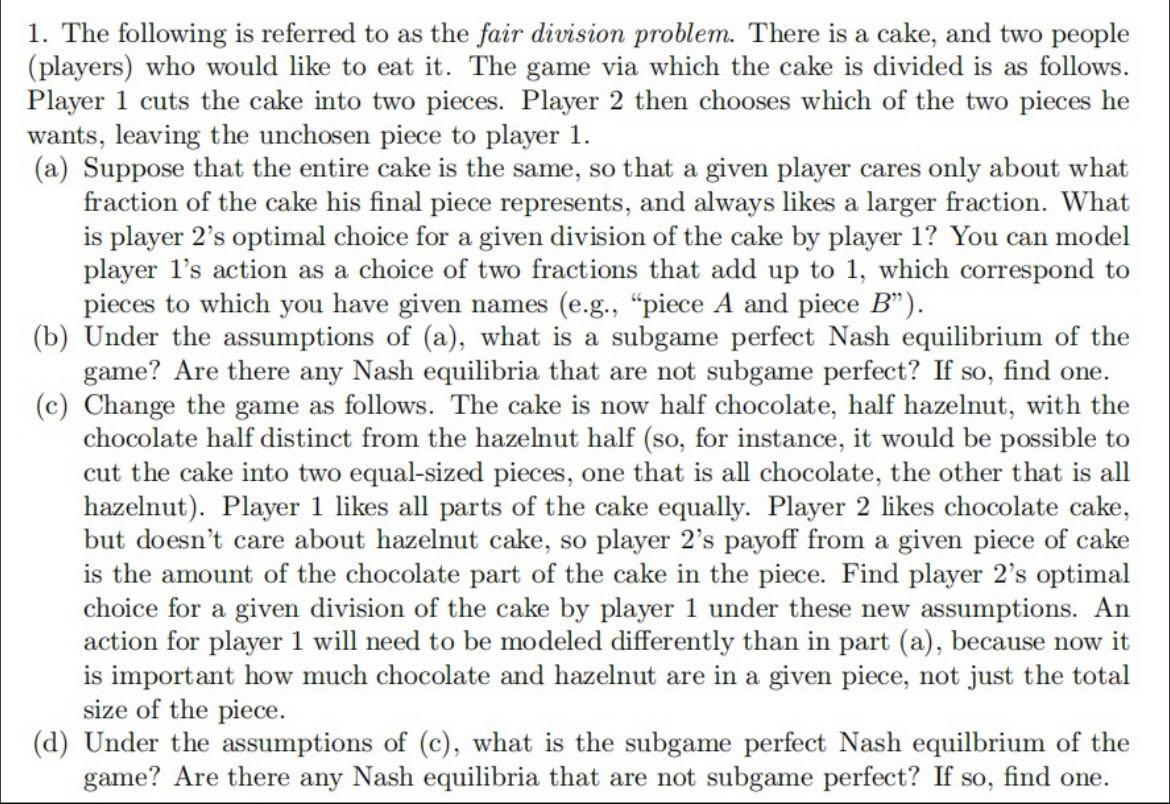 pls answer in details
pls answer in details
1. The following is referred to as the fair division problem. There is a cake, and two people (players) who would like to eat it. The game via which the cake is divided is as follows. Player 1 cuts the cake into two pieces. Player 2 then chooses which of the two pieces he wants, leaving the unchosen piece to player 1. (a) Suppose that the entire cake is the same, so that a given player cares only about what fraction of the cake his final piece represents, and always likes a larger fraction. What is player 2's optimal choice for a given division of the cake by player 1? You can model player l's action as a choice of two fractions that add up to 1, which correspond to pieces to which you have given names (e.g., piece A and piece B"). (b) Under the assumptions of (a), what is a subgame perfect Nash equilibrium of the game? Are there any Nash equilibria that are not subgame perfect? If so, find one. (c) Change the game as follows. The cake is now half chocolate, half hazelnut, with the chocolate half distinct from the hazelnut half (so, for instance, it would be possible to cut the cake into two equal-sized pieces, one that is all chocolate, the other that is all hazelnut). Player 1 likes all parts of the cake equally. Player 2 likes chocolate cake, but doesn't care about hazelnut cake, so player 2's payoff from a given piece of cake is the amount of the chocolate part of the cake in the piece. Find player 2's optimal choice for a given division of the cake by player 1 under these new assumptions. An action for player 1 will need to be modeled differently than in part (a), because now it is important how much chocolate and hazelnut are in a given piece, not just the total size of the piece. (d) Under the assumptions of (c), what is the subgame perfect Nash equilbrium of the game? Are there any Nash equilibria that are not subgame perfect? If so, find one. 1. The following is referred to as the fair division problem. There is a cake, and two people (players) who would like to eat it. The game via which the cake is divided is as follows. Player 1 cuts the cake into two pieces. Player 2 then chooses which of the two pieces he wants, leaving the unchosen piece to player 1. (a) Suppose that the entire cake is the same, so that a given player cares only about what fraction of the cake his final piece represents, and always likes a larger fraction. What is player 2's optimal choice for a given division of the cake by player 1? You can model player l's action as a choice of two fractions that add up to 1, which correspond to pieces to which you have given names (e.g., piece A and piece B"). (b) Under the assumptions of (a), what is a subgame perfect Nash equilibrium of the game? Are there any Nash equilibria that are not subgame perfect? If so, find one. (c) Change the game as follows. The cake is now half chocolate, half hazelnut, with the chocolate half distinct from the hazelnut half (so, for instance, it would be possible to cut the cake into two equal-sized pieces, one that is all chocolate, the other that is all hazelnut). Player 1 likes all parts of the cake equally. Player 2 likes chocolate cake, but doesn't care about hazelnut cake, so player 2's payoff from a given piece of cake is the amount of the chocolate part of the cake in the piece. Find player 2's optimal choice for a given division of the cake by player 1 under these new assumptions. An action for player 1 will need to be modeled differently than in part (a), because now it is important how much chocolate and hazelnut are in a given piece, not just the total size of the piece. (d) Under the assumptions of (c), what is the subgame perfect Nash equilbrium of the game? Are there any Nash equilibria that are not subgame perfect? If so, find one
 pls answer in details
pls answer in details





